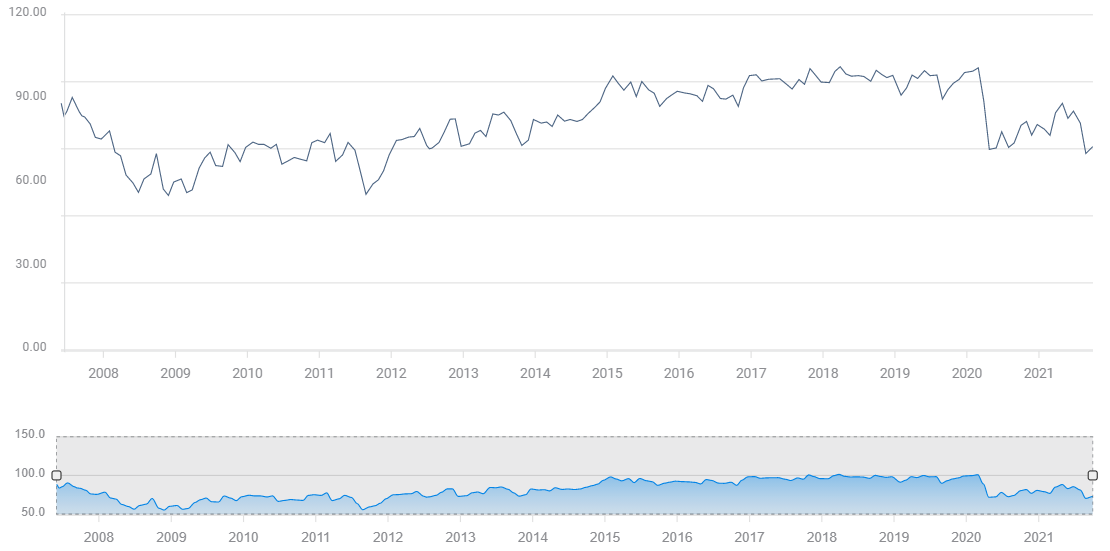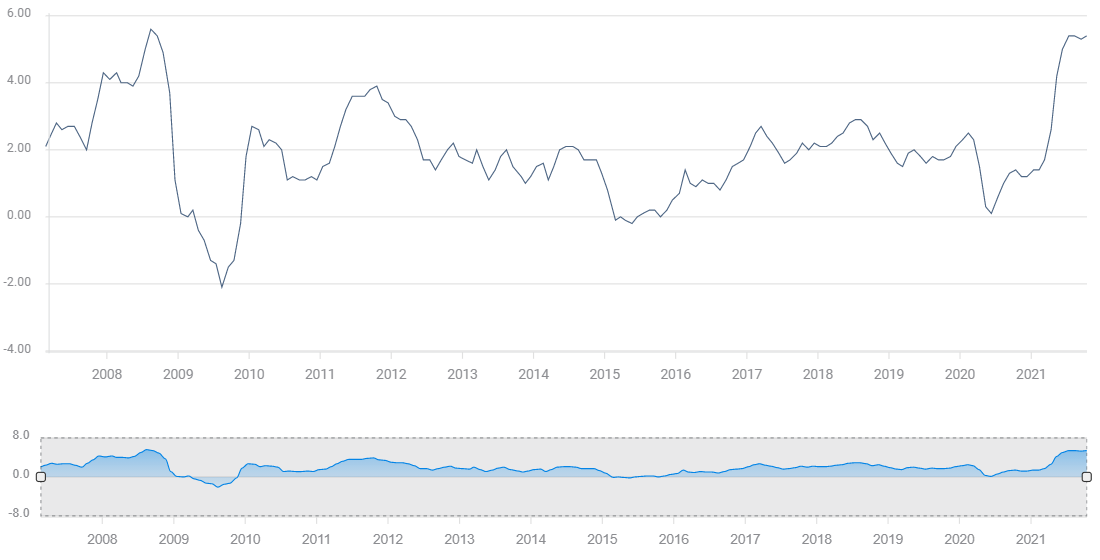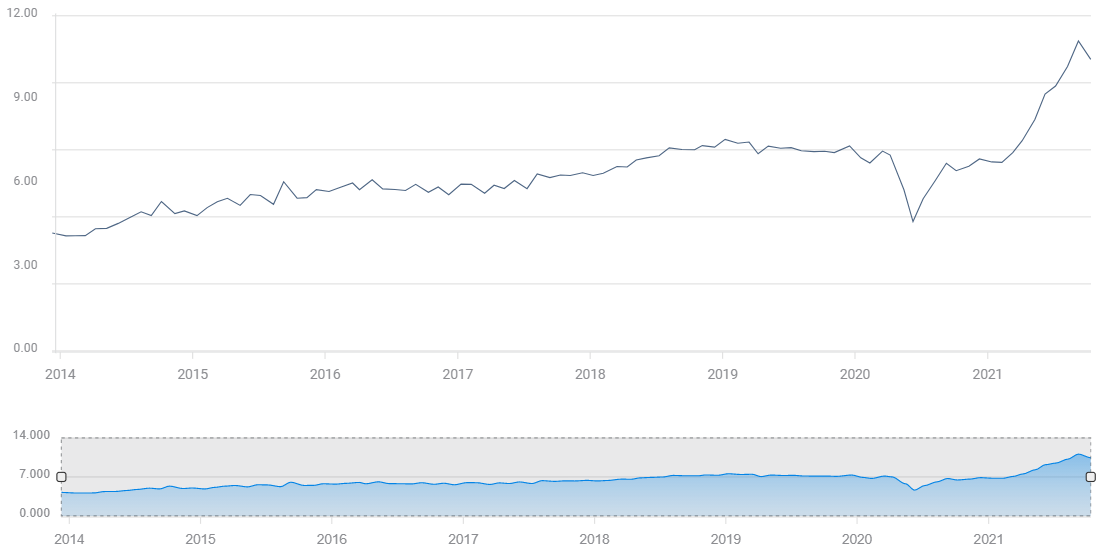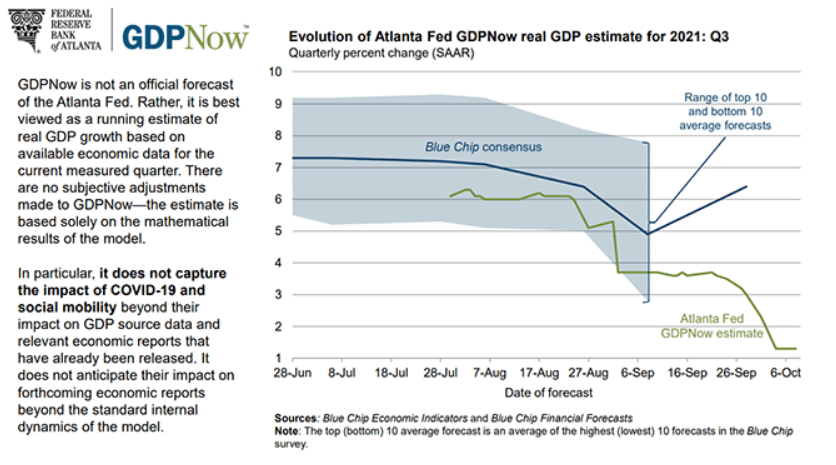- Consumer outlook forecast to improve marginally in September.
- Inflation is eroding purchasing power and sentiment.
- Labor and supply shortages have lowered third quarter economic growth.
- Markets see sentiment as a prelude to consumer spending and the Fed's taper.
Consumers have exchanged pandemic uncertainty for inflation and the trade may be starting to damage the economic recovery.
The University of Michigan Consumer Sentiment Index is expected to rise slightly to 73.1 in October from 72.8 in September. Outlook reached a pandemic low of 70.3 in August.
Michigan Consumer Sentiment Index
Wages and inflation
Consumers dislike inflation. Rising prices are a direct and immediate tax on income. Wages increase only at long intervals, household expenses can climb every shopping trip.
Average Hourly Earnings gained 4.6% on the year in September. Annual consumer inflation was 5.4% in September, the highest since July 2008, and the second largest annual gain in three decades.
CPI
FXStreet
A typical family's purchasing power shrank by the 0.8% difference last month. Multiply that for 12 months and you have a potential 9.6% drop in consumption in a year. The effect on purchases is conditional because families often dip into savings to make up the difference.
Even so, September’s 5.4% increase in the Consumer Price Index (CPI) does not capture the full impact of inflation on household budgets and by extension on the economy.
The Federal Reserve prefers tracking core inflation rates, excluding food and energy costs, as more reflective of long-term price trends. Households and the economy do not have that option.
For consumers food and energy are inelastic goods, their consumption does not drop when prices rise.
Americans do not drive appreciably less when gas is over $3 a gallon as it is now, than when it was under $2 just a year ago. The trucks that deliver food, the trains that cart products from the West coast ports to the rest of the country, the police cars, ambulances, FedEx vans and fire engines do not change their schedules for gasoline prices.
Energy and most food costs have been rising much faster than the general index.
Food prices climbed 1.2% in September after a 0.4% increase in August and were 4.5% higher on the year. Meat expenses were up 3.3% in September and 12.6% annually.
Gasoline prices rose 1.2% last month following a 2.8% increase in August and a 2.4% gain in July, bringing the annual surge to 42.1%. Fuel oil, which heats many older homes, jumped 3.9% in September and is 42.6% more costly on the year.
Americans have not seen this kind of damaging inflation in a generation. With no surcease on the horizon, even the Fed has admitted current inflation will be longer and higher than anticipated, consumer attitudes are becoming gloomy.
Labor market
In a normal economy the ability to find work is a major component of consumer optimism.
Even though there were 10.5 million open jobs in August, according to the Jobs Openings and Turnover Survey (JOLTS), and that is down from a record 11 million in July, workers remain pessimistic. Employers filled only 194,000 positions in September and 366,000 in August, far less than forecast and the one million average in June and July.
JOLTS
FXStreet
Worker diffidence has been blamed on the continuing pandemic, vaccination mandates, excessive unemployment benefits and a preference for flexible homework which may not register in official statistics and is probably a combination of several factors..
While the cause may be puzzling, the effect of the labor shortage is not. Employers in many fields have been forced to offer higher wages and in some cases signing bonuses, all inflationary, to find workers. Yet even this standard reaction to the labor shortage has not permitted wages to keep pace with inflation.
US GDP
The impact of labor and supply shortages on the US economy has been substantial. The Atlanta Fed’s GDPNow estimate for the third quarter has fallen steadily from over 6% in August to just 1.3%. The next revision is after Retail Sales on Friday October 15.
Conclusion: The state of the economy does matter to the Fed
Consumer sentiment usually provides an early insight into consumption. In the US economy the well-known 70% of GDP that is tied to consumer spending is the logic behind market attention. That connection did not pan out in August when the Michigan Index plunged to 70.3 from 81.2 but Retail Sales rebounded from a 1.1% loss in July and rose 0.7%.
The negative risk to consumption is the main economic connection for sentiment. If US consumers pull back on spending, weak GDP growth in the third quarter could easily turn negative. Retail Sales in September are forecast to fall 0.2%. The longer consumers remain depressed the greater the likelihood their angst carries over into spending.
Weak sentiment and perhaps ebbing consumer spending will not dissuade the Fed from beginning its bond reductions before the end of the year. The taper, however, is a flexible device. If consumers are unhappy, the rush to sell Treasuries, raising yields and the dollar will likely abate until optimism returns.
Information on these pages contains forward-looking statements that involve risks and uncertainties. Markets and instruments profiled on this page are for informational purposes only and should not in any way come across as a recommendation to buy or sell in these assets. You should do your own thorough research before making any investment decisions. FXStreet does not in any way guarantee that this information is free from mistakes, errors, or material misstatements. It also does not guarantee that this information is of a timely nature. Investing in Open Markets involves a great deal of risk, including the loss of all or a portion of your investment, as well as emotional distress. All risks, losses and costs associated with investing, including total loss of principal, are your responsibility. The views and opinions expressed in this article are those of the authors and do not necessarily reflect the official policy or position of FXStreet nor its advertisers. The author will not be held responsible for information that is found at the end of links posted on this page.
If not otherwise explicitly mentioned in the body of the article, at the time of writing, the author has no position in any stock mentioned in this article and no business relationship with any company mentioned. The author has not received compensation for writing this article, other than from FXStreet.
FXStreet and the author do not provide personalized recommendations. The author makes no representations as to the accuracy, completeness, or suitability of this information. FXStreet and the author will not be liable for any errors, omissions or any losses, injuries or damages arising from this information and its display or use. Errors and omissions excepted.
The author and FXStreet are not registered investment advisors and nothing in this article is intended to be investment advice.
Recommended Content
Editors’ Picks

EUR/USD holds above 1.0400 in quiet trading
EUR/USD trades in positive territory above 1.0400 in the American session on Friday. The absence of fundamental drivers and thin trading conditions on the holiday-shortened week make it difficult for the pair to gather directional momentum.

GBP/USD recovers above 1.2550 following earlier decline
GBP/USD regains its traction and trades above 1.2550 after declining toward 1.2500 earlier in the day. Nevertheless, the cautious market mood limits the pair's upside as trading volumes remain low following the Christmas break.

Gold declines below $2,620, erases weekly gains
Gold edges lower in the second half of the day and trades below $2,620, looking to end the week marginally lower. Although the cautious market mood helps XAU/USD hold its ground, growing expectations for a less-dovish Fed policy outlook caps the pair's upside.

Bitcoin misses Santa rally even as on-chain metrics show signs of price recovery
Bitcoin (BTC) price hovers around $97,000 on Friday, erasing most of the gains from earlier this week, as the largest cryptocurrency missed the so-called Santa Claus rally, the increase in prices prior to and immediately following Christmas Day.

2025 outlook: What is next for developed economies and currencies?
As the door closes in 2024, and while the year feels like it has passed in the blink of an eye, a lot has happened. If I had to summarise it all in four words, it would be: ‘a year of surprises’.

Best Forex Brokers with Low Spreads
VERIFIED Low spreads are crucial for reducing trading costs. Explore top Forex brokers offering competitive spreads and high leverage. Compare options for EUR/USD, GBP/USD, USD/JPY, and Gold.



